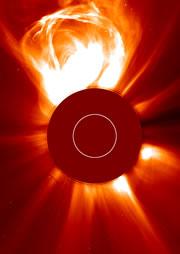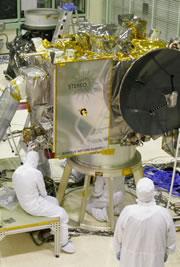 Scientists are set to get an even better view of solar ejections.SOHO Consortium, ESA, NASA
Scientists are set to get an even better view of solar ejections.SOHO Consortium, ESA, NASAA pair of solar satellites are due to lift off Wednesday in an effort to provide researchers with their first three-dimensional images of the Sun's surface.
Scientists hope the US$550 million Solar TErrestrial RElations Observatory (STEREO) will give them a better understanding of several solar phenomena, including coronal mass ejections: massive bursts of plasma that can disrupt or damage satellites in Earth's orbit.
"When one of these storms hits Earth, it can trigger all sorts of electrical effects," says Michael Kaiser, STEREO's chief project scientist at NASA's Goddard Space Flight Center in Greenbelt, Maryland. "It can cause GPS spacecraft to give erroneous positions and affect cell phone communications."
“When one of these storms hits earth it can trigger all sorts of electrical effects.”
Michael Kaiser,
STEREO
Two-dimensional images of the Sun, already available, yield little information as to how mass ejections happen or what speed they leave the Sun's surface. It's a bit like trying to guess how fast a smoke ring is travelling if it is blown directly at you from across the room, says Kaiser. "It's hard to do because all you see is the smoke ring expanding."
STEREO's solution is as simple as a view-master: The two spacecraft will be separated by millions of kilometres and will create two slightly offset pictures of the Sun. Combining the two images will give a three-dimensional view of the surface and its features.
A current generation of space weather satellites already keeps watch for solar eruptions headed towards Earth, but STEREO should be able to supply new details of the speed, size, and exact direction of such eruptions.
Wind Gauge
The two spacecraft can be used to study more than just the Sun's surface, says Tai Phan, a physicist at Berkeley's Space Science Laboratory in California.
 One of the satellite pair getting ready for use.To get into place, the pair will whip around the Moon till one is flung into orbit ahead of the Earth, and the other falls back behind our planet. Click for an animation.NASA
One of the satellite pair getting ready for use.To get into place, the pair will whip around the Moon till one is flung into orbit ahead of the Earth, and the other falls back behind our planet. Click for an animation.NASAUsing magnetic field and particle detection instruments, researchers should be able to probe the solar wind, a constant flux of particles that stream from our parent star. In particular, Phan says, they should be able to learn more about magnetic reconnection, the process by which magnetic lines of force break and rejoin. This can accelerate particles in the solar wind, causing problems for satellites.
If such reconnection events were sufficiently well understood, they could perhaps be detected in other, more exotic cosmic phenomena, such as around black holes, giving scientists novel data. "Reconnection is important for astrophysical applications," says Phan. "I'm very excited."
STEREO's launch was delayed for several months after a glitch with the Delta II rocket that will send it into orbit. The delays cost $8-10 million according to Kaiser.
The two craft are scheduled to lift off shortly after 20:30 local time on Wednesday from the Kennedy Space Center in Cape Canaveral, Florida. They will then perform a series of orbits around the Moon to separate the craft, putting one in orbit around the Sun slightly ahead of the Earth, the other slightly behind.
ADVERTISEMENT
Kaiser says they should take their first images of the Sun by mid-December.
<p/> Visit our solarsatellitesreadyfo.html">newsblog to read and post comments about this story.
STEREO
